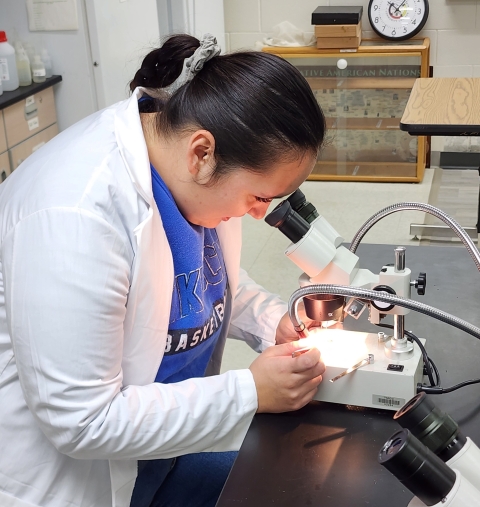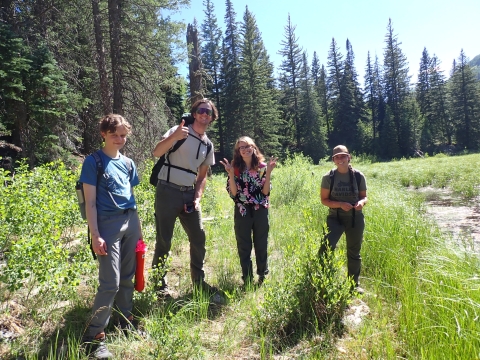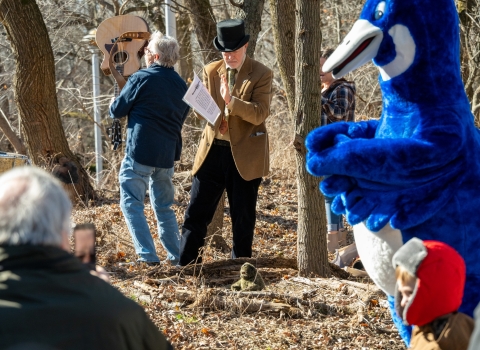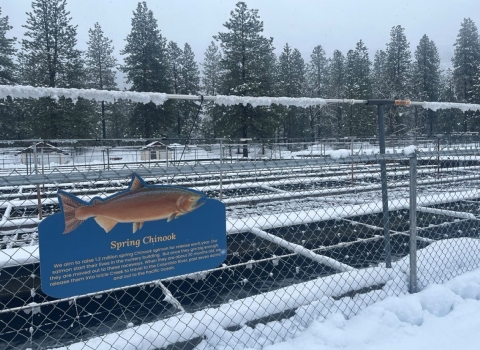Every year, species across the nation and around the globe face the threat of extinction – a threat that will only intensify as we encounter increasing disruptions to typical temperature and precipitation patterns. However, together, we hold the power to protect and restore the rich tapestry of life on our planet. The U.S. Fish and Wildlife Service (USFWS) is deeply committed to our mission, recognizing that meaningful change happens when we join forces with others who share our passion for conservation. This year has been special for many in the Mountain-Prairie Region (Region), as we have seen remarkable progress in our partnerships and collective efforts.
In 2023, Robert Krigsman from the Mountain-Prairie Regional Office and Jason Luginbill from the Kansas Ecological Office of the USFWS were awarded $100,000 for the Initiative for Increasing Academic Partnerships (IIAP) Project. The IIAP funded five conservation projects with the intention of building new partnerships in the Region. Each project was awarded $20,000 and prioritized the cultivation of new partnerships between the USFWS and underrepresented and undervalued institutions such as community colleges, tribal colleges, and other minority serving institutions. Additionally, important data is being collected from each project to help guide conservation of species across our Region.
At Haskell Indian Nations College, the IIAP project focused on establishing pollinator monitoring programs for the university wetlands in Kansas. The university wetlands had never been surveyed for pollinators prior to this project and, with the ongoing efforts to plant more native plants, the location was perfect for this project. This project used new technology to make pollinator monitoring and conservation accessible and replicable. Laura Mendenhall, a biologist with the USFWS, worked with university student Aaliyah Provost to establish permanent monitoring transects (physical boundary markers), a survey protocol, and data collection kits that can be used by non-experts to continue observing and assessing pollinator trends. Read more about this project and Aaliyah’s experience in 'Stewards of the Land: Native Women in STEM'.
In North Dakota, the USFWS worked with Turtle Mountain Community College on a project focused on insect pollinators’ role in supporting the health of agricultural crops and other plants. With more than 200,000 plant species relying on insect-mediated pollination, this project focused on documenting pollinator species in the area and the plant species they pollinate. Jerry Reinisch, Fish and Wildlife Biologist/Tribal Liaison with the USFWS, collaborated with college Professor Dr. Scott Hanson to conduct the first pollinator species surveys using DNA sequencing in the Turtle Mountain region of North Dakota, establishing baseline pollinator and host plant data. Over the course of the project, students were trained by Dr. Hanson in DNA-analysis techniques and scientific presentation methods. DNA samples were collected from approximately 400 insects, and 200 of these insect samples were analyzed. Further, sequencing of DNA from 50 insects allowed the students to identify the species of pollinators that were nectaring on a specific species of plant. DNA from the gut microfauna of 20 of the pollinators was also sequenced to aid in the identification.
At Fort Lewis College in Colorado, Terry Ireland, biologist with the USFWS, coordinated with professor Dr. Ross McCauley and his students to conduct surveys of the silverspot butterfly and its host plant, the bog violet. The silverspot butterfly is a species of interest because a subspecies of the butterfly - Speyeria nokomis nokomis - is listed as threatened under the Endangered Species Act. Their goal for this project was to determine whether new colonies or populations of the silverspot butterfly exist. The data gathered will assist the USFWS with status and management considerations for this butterfly.
In far northeastern Montana, the USFWS partnered with the Fort Peck Community College along the banks of the Missouri River. Laura Strong and Austin McCullough, biologists with the USFWS, worked with Professor Joanne Stewart and her environmental studies students to develop a long-term monitoring program that will record the response of culturally important plant and animal species to changing water levels in the Missouri River ecosystem. The Fort Peck Dam began releasing higher amounts of water during the endangered pallid sturgeon’s spawning and migration period to increase reproduction of this ancient species. Students are investigating how these pulses of increased water affect species important to the Fort Peck Tribes such as cottonwood, green ash, deer, and bird species.
In Colorado’s Grand Valley, Colorado Mesa University collaborated with the USFWS, Colorado Parks and Wildlife, and the Bureau of Land Management to conduct a monitoring project for pinyon jays, a bird species under review for listing under the Endangered Species Act. This project focused on monitoring for occupancy, reproduction, and foraging behaviors of pinyon jays. Jake Gottschalk, biologist with the USFWS, and Professor Paul Hampton worked together with Colorado Parks and Wildlife to train university students in identifying pinyon jays so that students could then conduct their own surveys and other monitoring efforts into 2025. This project will help increase the understanding of pinyon jays in the state of Colorado and is helping to foster connections and interest in bird conservation at Colorado Mesa University.
These projects would not have been possible without the passionate individuals and teams who dedicated their time and energy. Fostering meaningful relationships and building strong connections with each other and the ecosystems around us are vital steps toward a brighter future. The USFWS is truly excited to embark on this journey alongside so many incredible individuals and organizations. Together, we are not just safeguarding ecosystems; we are nurturing hope for future generations and honoring the intricate connections that bind us all to the natural world.








